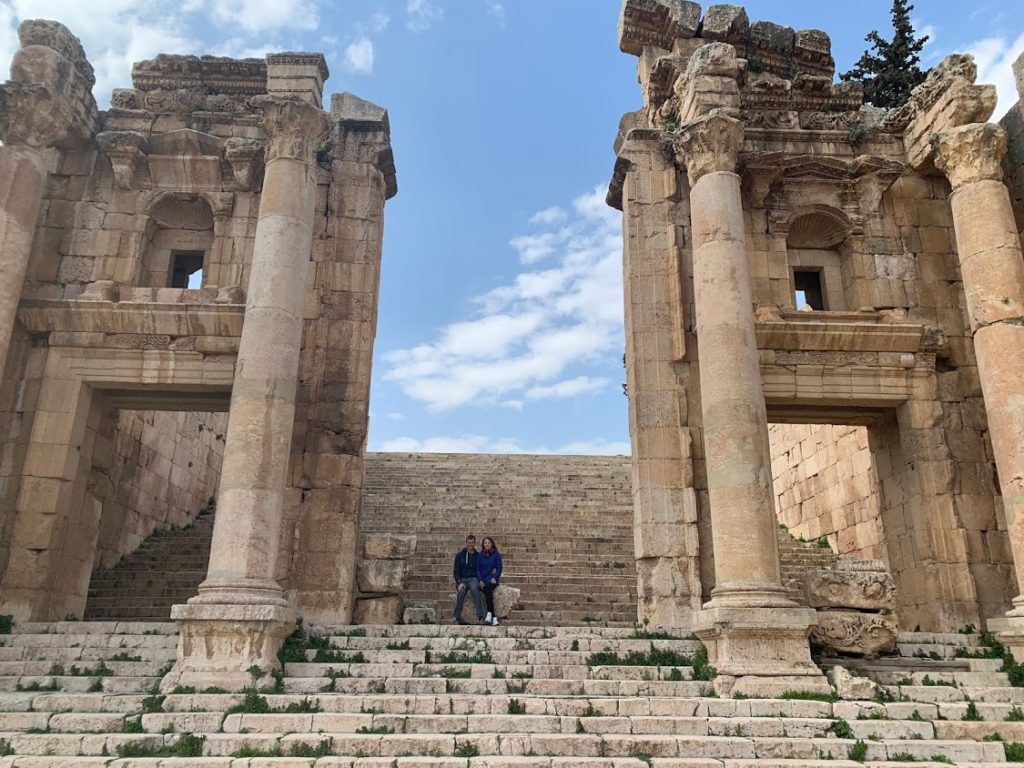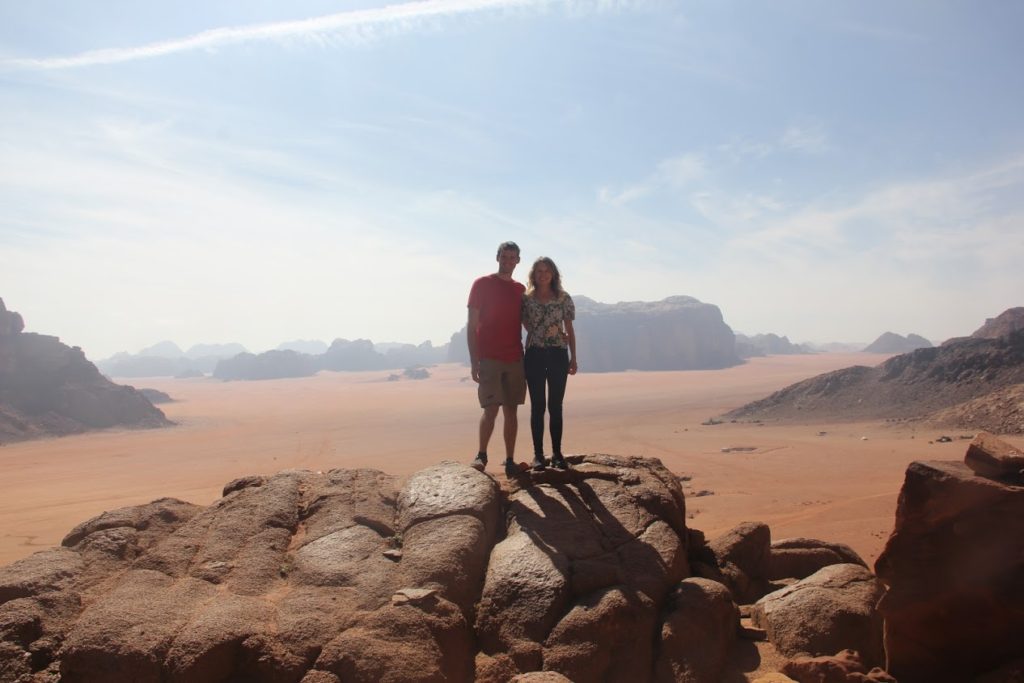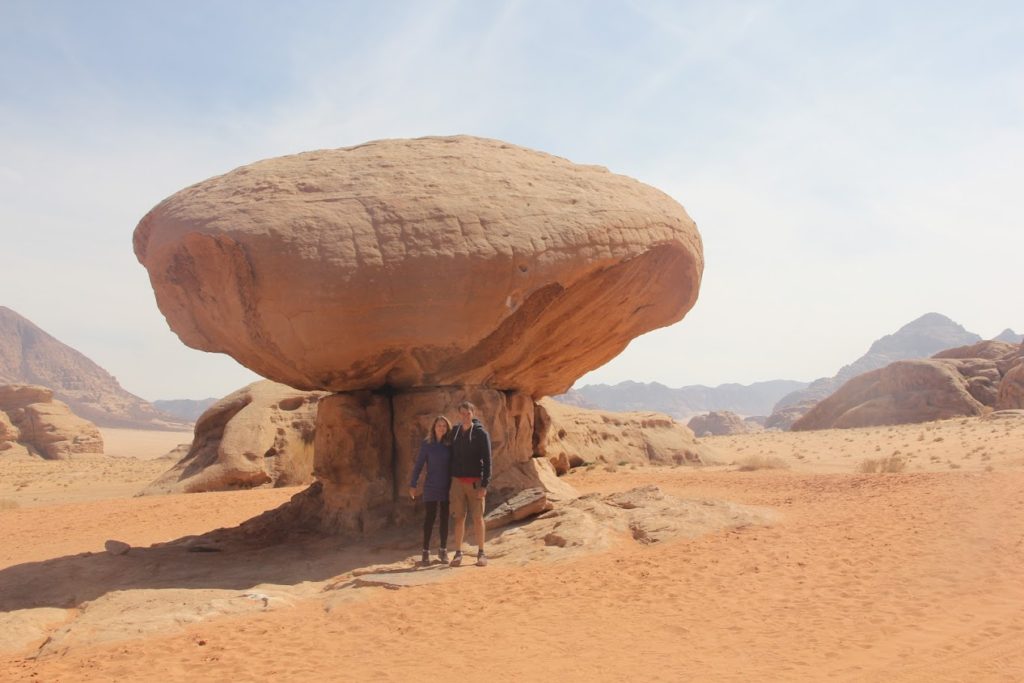Jordon, the custodian of the Middle East, was our first stop outside Asia. It’s one of the most stable countries in the region. It is also home to some of the most impressive treasures as you’ll see in this blog. It was the stop where Tamara’s mum would pay us a well deserved visit to explore the historical sites with us.
Amman
We began our journey through Jordon in the capital city of Amman. Located in the center of downtown Amman you’ll find the ancient ruins of the Citadel. The site sits high on a hill and provides full panoramic views of the city.

The most fascinating thing about this historical site is that it’s one of the world’s oldest continuously inhabited places dating back to the Neolithic period. The Roman amphitheate is just a 20 minute walk down the hill. There are no tour guides or security and it’s great to be able to explore the amphitheatre. It kind of feels surreal that the amphitheatre also acts as a playground to most kids there hanging out after school.
Amman is built on seven hills so you do need a taxi to explore the city. We used Careem to get us to most places and the drivers there were great. We found the taxis that just pitched up outside the local monuments a bit crazy and it was some of the worst driving we would see as they would be on their phones the whole time (texting and having very very loud phone calls) as they’re weren’t accountable compared to an app. They were also relentlessly cross selling us anything they could.
Dead Sea
We planned some day trips from Amman, the first being the Dead Sea. When we got there it was a bit odd as a lot of building work was happening. The Dead Sea is located at the lowest point on Earth, and we discovered the sea level shrinking at an alarming rate – the surface level is dropping more than a metre a year. It would explain why when we’re in the Dead Sea it was quite a bit of a walk from the hotel as the sea level had dropped so much over the years. The positive news is the Jordon government is working to build a pipe from the Red Sea to get its depth back to the original levels.
We had a lot of fun floating in the Dead Sea which felt like a surreal experience as the water always propelled you up, so it was impossible to walk about in the Dead Sea. It’s really popular to have a Dead Sea Mud Bath. We spent 15 minutes in the sea floating about as the water is so salty it is incredibly dehydrating so you won’t want to soak up the sea for long. We then covered ourselves in Dead Sea Mud famous for its minerals before taking another dip in the sea before we left.
Jerash
The second was day trip from Amman to Jerash , one of the best preserved sites of Roman architecture outside Italy and 45 min drive from Amman. When the Romans conquered Syria in 64BC, Gerasa, as it was known then, became one of the ten great Decapolis cities belonging to the Greek- Roman federation.
From the Forum, the colonnaded main street, the Cardo Maximus leads you through the centre of the town.

We had great fun exploring the ruins and wondering about the life that was once lived in this Ancient City.
Petra
Our next stop would be Petra, considered as one of the modern ‘7 Wonders of the World’. We started by visiting Little Petra known as the ‘back door of Petra’. The area is picturesque and there are some good hikes to the top of Little Petra.
The next day we channeled our Indiana Jones by visiting the treasury. It’s a lot of hiking in Petra as the area covers 60km. It was quite cold when we visited Jordon and we were glad we didn’t come in the summer as you need it to be cool especially for the hikes. We saw the Treasury in the morning and was beautiful with the camels outside. We then continued visiting the churches, royal tombs, theatres as there is so much to see. Finishing with a hike up the famous monastery which takes probably an hour each way. We saw some people come up down with donkeys which did look insane as the hike was quite steep.

While the City of Petra is best known as being the epic set at the end of Indiana Jones and the Last Crusade, it does actually have quite an interesting history. The City of Petra is believed to date back to 9000 BC and to have then been established as the capital of the Nabataean Kingdom around the 4th century BC. The surrounding area is incredibly picturesque and could spend a week hiking all the different trails here. We tried to cover as much ground as we could in one day.
Wadi Rum
After dropping Tamara’s Mum off at the airport we made our way to Wadi Rum where the Bedouin tribes are the desert people that still inhabit this area. We were greeted with our guide who drove us around the desert’s dramatic landscape on the back of his jeep.
The guide took us to some of the best places and we climbed a dune to see the full panorama view of the desert. It was a bit tricky at first as our shoes kept sinking but completely worth the experience when we got to the top. We then raced each other down to the bottom.

After climbing various different trails the sunset came down and we made our way back to camp. A Bedouin style BBQ was being prepared for us full of meat, potatoes and vegetables. We were led to the back of the camp where two Bedouins where uncovering some sort of desert manhole. It turned out to be our dinner cooking in there!
They lifted the lid and underground our slow cooked BBQ rose in the air. We had a meal of meat, hummus and an array of Bedouin specialities. We really enjoyed our time in the desert and getting to know the Bedouin traditions as it was good to escape city living for a couple of days.
Aqaba
After exploring the vast plains of Wadi Rum and the ancient treasures of Petra. We decided to head south and to the beach of Aqaba on the Red Sea. From our hotel room we could see Jordon, Saudi Arabia, Egypt and Israel all from one point. We spent a day relaxing in the town before continuing our Middle East adventure with the second stop being Egypt!











